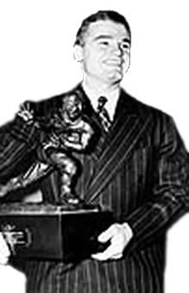Adel Hero Nile Kinnick named Big Ten Icon
Iowa’s only Heisman Trophy winner and Adel hero Nile Kinnick has been named Big Ten Icon No. 7, Big Ten officials announced Tuesday, January 18th.
The native of Adel, Iowa stood just 5-foot-8 and weighed 170 pounds, but did it all for the Hawkeyes, serving as a halfback, defensive back and punter on the football team, and was the basketball team’s second-leading scorer as a sophomore.
As a senior, Kinnick was elected the University of Iowa’s class president. On the football field, the 1939 Hawkeyes were known as “The Ironmen,” still regarded as one of the best teams in school history and Kinnick earned much of the credit.
In all, Kinnick accounted for 107 of Iowa’s 130 points – and that was just on offense. Defensively, Kinnick set a new Iowa record with eight interceptions that still stands today.
Kinnick’s jersey number 24 is one of only two numbers retired by the Hawkeyes. He was inducted into the inaugural class of the College Football Hall of Fame in 1951.
Kinnick not only won the Heisman Trophy, but was a consensus first team All-American, the winner of the Chicago Tribune’s Silver Football, as the Big Ten’s Most Valuable Player; the Walter Camp Award; the Maxwell Award; and the Associated Press’ Male Athlete of the Year, trumping New York Yankees great Joe DiMaggio and boxing champion Joe Louis.
At the Heisman dinner in New York, two years before the United States entered World War II, Kinnick delivered a passionate, patriotic speech that reportedly caused the 700 people in attendance to give him a standing ovation. The Boston Post’s Bill Cunningham covered the event and wrote, “This country’s OK as long as it’s producing Nile Kinnicks. The football part is incidental.”
At his graduation the following spring, Kinnick delivered the commencement speech for the university’s class of 1940. He turned down several opportunities to play professional football and a contract offer from the Yankees, and elected to attend Iowa law school, where he was third in his class after one year. Kinnick joined the Naval Air Reserve in 1941 and was training to be a fighter pilot. He died in June 1943 during a routine training flight off the coast of Venezuela.
The Big Ten Icons series continues Sunday at 4:30 p.m. with a profile of the revered 1939 Heisman Trophy winner and namesake of the Hawkeyes’ football stadium.







